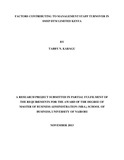| dc.description.abstract | Employee turnover is a key competitive parameter in today’s business world characterized by its
turbulent operating environment. Companies today generally do recognize the contribution that
their employees play in delivering the organization’s goals and objectives and as a result they put
much effort in reducing the rate of turnover. The study sought to establish the factors that
contribute to management turnover at Small and Micro Enterprise Programme (SMEP). In
attempting to achieve the objective, a case study approach was adopted. The population of the
study consisted of all management staff at SMEP who was 64 in total. The study used primary
data that was collected through an interview guide and interviews were made with six identified
respondents that were considered to be privy with the research objectives. The data obtained
from the interview guide was analyzed using qualitative analysis. Content analysis was adopted
in this study because the researcher was able to describe, interpret and criticize the subject matter
of the research since it would have been difficult to do so numerically. The findings of the study
showed that the rate of Management staff turnover was portraying negatively on the
organization’s reputation, destabilized the organization’s operations, and as a result had the risk
of making the organization loose sensitive information to the competitor. Several factors were
found to be contributing to the high level of employee turnover. These factors ranged from what
was considered as unfair remuneration distribution, organization leadership, job satisfaction,
inadequate training and development programs and setting of high targets that are not achievable.
Understanding voluntary turnover has multiple direct and indirect costs incurred and firms when
implementing changes should be aware that this might result in increased turnover, partly
because changes in the pattern of work are likely to result in a greater incidence of shocks. There
is need for microfinance businesses to re-visit and analyse their own labour and cost experience.
They should not only identify reasons why staffs leave, but also what might make them stay. An
industry-wide study into labour recruitment and retention would greatly advance knowledge of
the cause of turnover and the status of HRM practice in the Kenyan microfinance sector. | en |

